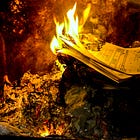Trail of Destruction, Pt. 4: The New Orleans CIA Files
Agency records on CIA contacts with Lee Harvey Oswald get ‘deep-sixed’ within days of JFK's murder
[Editor’s Note: This is the fourth installment in the JFK Facts series, “Trail of Destruction.” New installments will appear every Wednesday.]

For much of 1963, 23-year-old ex-Marine Lee Harvey Oswald was living in New Orleans, the Big Easy, that decadent Louisiana port city that was home to a teeming underworld of federal agents, FBI informants, undercover CIA officers, soldiers of fortune, white supremacists, scoundrels, and spies.
The period from April to September 1963 gave rise to Oswald’s public “legend.” He was identified as a political agitator ostensibly sympathetic to the Cuban revolution and its leader, Fidel Castro. He acted as the New Orleans face of the Fair Play for Cuba Committee (FPCC), a New York-based organization which sought normalized U.S.-Cuban relations. As the only FPCC member in New Orleans, Oswald repeatedly faced off with paid CIA assets at a time when both the CIA and FBI had slated his organization for penetration, disruption, and destruction.
But the CIA New Orleans office files on Oswald’s pro-Castro antics in the summer of 1963 (and his many contacts with anti-Castro exiles) were destroyed shortly after President John F. Kennedy was assassinated on November 22, 1963.
The trail of destruction would run from the Oval Office to the Bethesda fireplace of Dr. James Humes, to the Dallas office of the FBI, and continue in New Orleans and beyond.
Three months earlier, on Aug. 9, 1963, the man arrested for shooting Kennedy had an altercation with anti-Castro Cuban exiles as he was handing out pro-Castro leaflets on busy Canal Street. Four Cuban men confronted him, threw his pamphlets into the air, and physically threatened him for publicly defending Castro.

Police arrested Oswald and the four Cubans for disturbing the peace. But while Oswald was jailed for a night, the Cubans went free. Four days later, the young ex-Marine faced his antagonists in court. He was fined $10; the Cuban agitators paid nothing.
Soon interviewed on TV about his Marxist sympathies, Oswald found himself debating Carlos Bringuier — the Cuban exile who had scuffled with him — on the radio. Bringuier was the New Orleans delegate of the CIA-funded anti-Castro Student Revolutionary Directorate (DRE), known to North American newspaper readers as the Cuban Student Directorate. Undercover officer George Joannides, chief of the psychological warfare branch of the Miami station, supervised the DRE under the direction of Cuban operations chief David Atlee Phillips in a CIA operation codenamed AMSPELL.
Within 48 hours of President Kennedy’s death, the DRE issued a press release and special edition of its newspaper, broadcasting the first JFK assassination “conspiracy theory”: that Oswald had killed Kennedy on Fidel Castro’s orders.
In short, the hidden hand of the CIA in New Orleans is one key to the JFK assassination story.
Keep reading with a 7-day free trial
Subscribe to JFK Facts to keep reading this post and get 7 days of free access to the full post archives.







